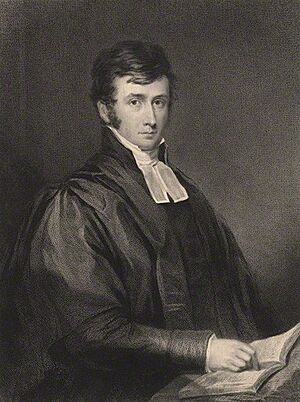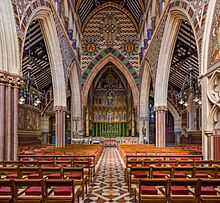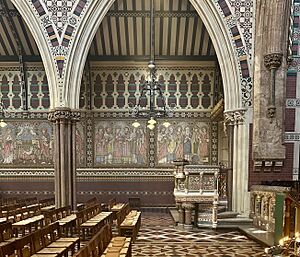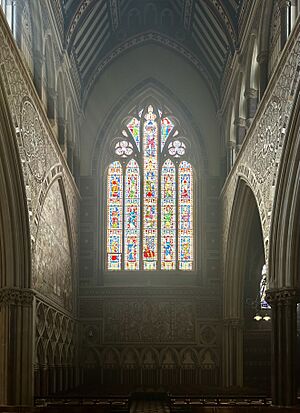All Saints, Margaret Street facts for kids
Quick facts for kids All Saints, Margaret Street |
|
|---|---|
|
Clockwise from upper left: the exterior of All Saints; the chancel and the high altar; a panorama of the interior.
|
|
| Denomination | Church of England |
| Churchmanship | Anglo-Catholic |
| History | |
| Consecrated | 1859 |
| Architecture | |
| Heritage designation | Grade I |
| Architect(s) | William Butterfield |
| Style | Gothic Revival |
| Administration | |
| Diocese | London |
| Province | Canterbury |
All Saints is a special church in London, England. It's on Margaret Street in an area called Westminster. This church is known for its unique style, called Anglo-Catholic.
It started in the late 1700s as the Margaret Street Chapel. In the 1830s and 1840s, it became part of the Oxford Movement. This movement led to the church being rebuilt in the 1850s. A famous architect named William Butterfield designed the new building. The Society of All Saints Sisters of the Poor was also started around this time, connected to the church.
All Saints is considered a masterpiece by Butterfield. It was a very important building for the High Victorian Gothic style. This style was popular in British architecture from about 1850 to 1870. The church is famous for its Gothic design, the materials used, and its beautiful inside decorations. It also has a long history of great music, going back to the 1840s.
Contents
A Look Back: Church History
The First Church: Margaret Street Chapel
The first church building was called Margaret Street Chapel. It was built in 1752. At first, it was used by different Christian groups. In the 1770s, a philosopher named David Williams used it. He wanted to promote a "universalist liturgy."
The chapel was closed for a while in the 1780s. Later, it became a church within the Church of England. In 1825, a fire damaged the chapel. In 1827, a banker named Henry Drummond bought the building. He hoped to bring new ideas into the Church of England.
The Oxford Movement's Influence
In 1829, William Dodsworth became the minister of Margaret Street Chapel. He was an early supporter of the Oxford Movement. This was a religious movement in the 1800s. It wanted the Church of England to return to older Catholic traditions and practices.
Important leaders of this movement included John Henry Newman and Edward Bouverie Pusey. They wrote ideas in books called Tracts for the Times. These books talked about the importance of bishops and church traditions. They also stressed the importance of the eucharist, a special church service. The Anglo-Catholicism style of worship grew from this movement.
Dodsworth brought many of these ideas to Margaret Street Chapel. He was a popular speaker. Many people in London who supported the Oxford Movement came to the chapel. After Dodsworth left in 1837, Frederick Oakeley became the minister in 1839.
Oakeley changed the inside of the chapel. He made it a place to show off the new worship styles of the Oxford Movement. In 1845, Oakeley left the Church of England and joined the Roman Catholic Church. William Upton Richards then became the minister.
Building the New All Saints Church
The Oxford Movement also cared about how churches looked. Oakeley wanted to rebuild the chapel in a proper church style. He started raising money for this project. Upton Richards continued this plan.
A group called the Cambridge Camden Society also wanted to build a church. They wanted it to have a perfect Gothic architecture style. In 1845, a leader of this group, Alexander Beresford Hope, realized they could combine their goals with the chapel's rebuilding.
Upton Richards bought the land for the new church in 1849. The new church area, called the Ecclesiastical District of All Saints', was created on July 30, 1849. William Butterfield was chosen as the architect. The old chapel held its last service in April 1850.
The foundation stone for the new church was laid on All Saints' Day, 1850. While the new church was being built, the church members met in other places. The new church cost about £70,000, which was a lot of money back then! Many large donations helped pay for it.

The Oxford Movement also led to the creation of religious groups for women. In 1848, Upton Richards met Harriet Brownlow Byron. He encouraged her to live a religious life. In 1856, Byron and two other women founded the Society of All Saints (Sisters of the Poor). They helped people with disabilities and orphaned children.
Maria, the older sister of the famous poet Christina Rossetti, joined this group in 1856. Christina Rossetti also worked with the society later in her life.
All Saints, Margaret Street: A New Era
The new All Saints church building was officially opened on May 28, 1859. Bishop Archibald Campbell Tait led the ceremony. Upton Richards was the vicar for ten years until 1869. He started a choir school for the church in 1860. He remained the vicar until he passed away in 1873.
Many vicars have led All Saints over the years. Berdmore Compton took over in 1873. Later, William Allen Whitworth became vicar in 1886. He started a newspaper for the church and offered Welsh services. During the Victorian era, Princess Alexandra of Denmark often visited the church. She sometimes brought her husband, who would become Edward VII.
From 1908 to 1934, Henry Mackay was the vicar. He made the church services more formal. He started using incense and paschal candles. He also began calling the services "Mass." In 1934, Dom Bernard Clements became the vicar. He oversaw celebrations for the 100th anniversary of Frederick Oakeley's time at the chapel.
During World War II, London was bombed. The church's choir members were sent to the countryside for safety. The roof of the parish school caught fire. Dom Bernard passed away in 1942. In 1959, All Saints celebrated its 100th anniversary. The choir school closed in 1967 due to money problems.
Later vicars included Michael Marshall (1969-1975) and David Sparrow (1976-1981). In 1982, David Hope became the vicar. He organized a celebration for the 150th anniversary of the Oxford Movement in 1983. He also brought back some old church traditions.
The current vicar is Fr. Peter Anthony. Since 2020, the church has been under the care of the Bishop of Fulham.
Church Design and Style
All Saints was a very important building for the Gothic Revival style in England. This style brought back ideas from medieval Gothic buildings. The writer Simon Jenkins called All Saints "England's most celebrated Victorian church." The historian Simon Thurley listed it as one of the ten most important buildings in the country.
The architect, William Butterfield, designed the church in a new way. He didn't just copy old medieval buildings. He added new ideas and materials, like brick. A writer from the 1800s, Charles Locke Eastlake, said Butterfield's design was a "bold and magnificent endeavour" to create a new style. The famous critic John Ruskin said that after seeing All Saints, "we may do anything."
Butterfield used building materials in a new and exciting way. All Saints is built of brick. Most Gothic Revival churches before it were made of grey stone. Butterfield wanted to "give dignity to brick." The bricks he chose were so good that they were more expensive than stone!
The outside of All Saints uses red brick with patterns of black brick. It also has bands of stone and carved parts. This means the decoration is built right into the structure. All Saints was the first building in London to use this "structural polychromy" style.
The inside of All Saints is especially famous for its decoration. Almost every surface is covered in patterns or designs. The floor has patterned tiles. The walls have geometric patterns made of brick, tile, and marble. There are also large pictures made from painted tiles. The ceiling is painted, and the wood behind the altar is painted and gilded.
The architectural historian Nikolaus Pevsner said the inside was "dazzling." He noted that "no part of the walls is left undecorated."
The back of the chancel has paintings on golden boards. These are inside a beautifully carved Gothic screen. This work was done by Ninian Comper and restored earlier work by William Dyce. The Lady Chapel is also decorated by Comper. The north wall has a large ceramic tile picture. It was designed by Butterfield and shows scenes from the Old Testament, a Nativity scene, and pictures of Early Church Fathers.
All Saints does not have many stained-glass windows. This is because there are many buildings around the church. The large west window was replaced in 1877. It shows a design based on the Tree of Jesse window in Wells Cathedral. Other windows were designed by Michael O'Connor.
The baptistery is in the south-west corner of the church. It is known for its marble tiles. The ceiling tiles show a picture of a Pelican in her Piety. This is a symbol of how humans fell and were saved.
Music at All Saints
Music has always been important at All Saints. One of the first musicians was Richard Redhead. He became the organist of Margaret Street Chapel in 1839. He stayed until 1864. In 1841, the vicar Frederick Oakeley translated a Latin hymn into English. It became the popular Christmas carol "O Come All Ye Faithful."
The church had a choir school that started in 1848. The boys from this school sang at the coronations of King Edward VII in 1902 and King George V in 1911. The famous actor Laurence Olivier was also a student at this school! The choir school closed in 1968. After that, sopranos (female singers) replaced the boys in the choir.
From 1868 to 1907, William Stevenson Hoyte was the organist. The composer Healey Willan often played for evening services at the church. Later, the music director Walter Vale arranged a piece by the Russian composer Sergei Rachmaninoff. Rachmaninoff himself came to the church in 1924 to hear Vale's arrangement.
The church's current organ was built in 1910-1911 by Harrison & Harrison. It was updated in 1957 and restored in 2002.
More to Explore
- List of churches and cathedrals of London
- Keble College, Oxford, which has a chapel designed by William Butterfield in a similar style.









